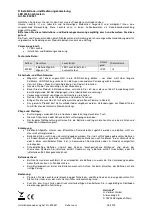
Calibration
Electronic Calibration (E-CAL)
VT300 Technical Manual, Rev. A4
34
Doc # TM-VT300-EN
4.3 Electronic
Calibration
(E-CAL)
To perform electronic calibration, you must set the
CAL MODE
scale parameter to
ELECTR
(see section
4.1).
Electronic calibration involves setting two values, using the indicator keypad:
The signal level in mV, corresponding to the zero, or dead-load point (see section
4.3.2).
The signal level in mV, corresponding to the maximum capacity of the scale (see
section
4.3.3).
To learn how to calculate these values from the load cell specifications provided by
the manufacturer, see section
4.3.1 below. You must perform both of the above for
the scale to be calibrated properly.
After calibrating the scale, you must save the values in permanent memories by
accessing the calibration menu and selecting
WRITE
(see section
4.4). It is also
advised to lock calibration (see section
4.5).
4.3.1
Calculating Calibration Values
Consider the following example. A scale has maximum capacity 30/60kg,
e=0.010/0.020kg, with 4 load cells, each with rated capacity 50kg (2mV) and dead
load 1.940kg. The load cell data, as noted in the manufacturer data sheet, is shown
in the following table.
Load cell
Output at 50kg
Zero balance
L/C1 1.9793mV
0.0257
mV
L/C2 1.9392mV
0.0276
mV
L/C3 1.9577mV
0.0553
mV
L/C4 1.9640mV
-0.0022
mV
To calculate the dead-load and span calibration values:
1. Calculate an average of the load cells’ rated output. In the example above, this
equals (1.9793+1.9392+1.9577+1.9640)/4=1.9600mV.
2. Calculate the combined output of the load cells when the scale is at maximum
capacity. In the example above, this equals 1.9600x60/4x50=
0.5880mV
. This is
the
span calibration value
.
3. Calculate an average of the load cells’ zero balance. In the example above, this
equals [0.0257+0.0276+0.0553+(- 0.0022)]/4=0.0266mV.
4. Calculate the scale dead-load. In the example above, this equals
1.9600mV*[1.940Kg/(4*50Kg)]=0.0190mV.
















































